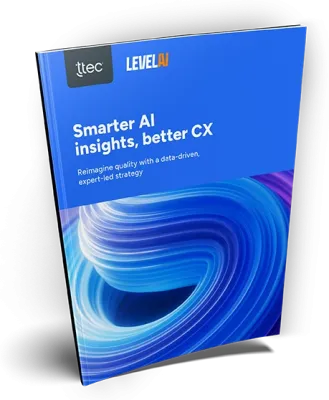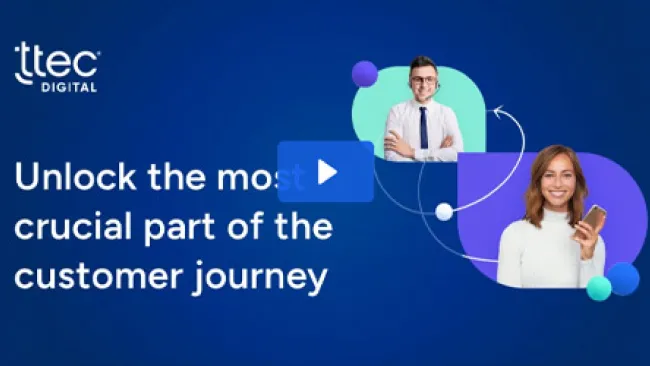“Why did they do that?”
Understanding what motivates customers – their intent – is a key piece of the customer experience (CX) puzzle. Do they want a simple transaction? Or do they want a complex, emotion-driven one? Knowing the difference can save time, money, and frustration for customers and brands alike.
These days, customer expectations are increasing rapidly. Understanding and mapping customer intent, and empowering employees to serve that intent, doesn’t just provide good CX; it’s simply good business. The companies that will win their markets in the next two to five years will use data, empathic analytics, and empowered employees to understand why customers are interacting with a brand – and use that intel to deliver the right message via the right channel at the right time.
Working with Forrester Consulting, TTEC examined the business benefits of intent mapping within the customer experience to create an intent mapping methodology and gleaned some interesting insights in a report. Here are some highlights.
Become proactive and empathetic
Meeting customers where they are is no longer enough. To orchestrate truly seamless experiences, companies need to know what is driving customers to make decisions they’re making. Layering intent-based insights on top of data analysis will lead to proactively serving customer needs and wants. This leads to faster, easier, better experiences.
Customer contact centers are traditionally seen as transactional and largely focused on cost minimization. That culture has been challenged over the last 10 years as we entered the age of customer centricity, and technology has created an increasingly demanding and empowered consumer. Fortunately, technology also provides firms with the tools to serve today’s consumer: self-service, AI, and machine learning converge to automate the highest-volume, most routine tasks in the service center.
But customer journey mapping is the first step. Charting how a customer navigates a particular scenario, and the choices they make in that journey, shifts the contact center from merely executing responses to measuring and learning from the customer point of view.
Use data and context to build the core element of intent. Analytics teams can partner with service center operations to find trends in the data that provide insights into a customer’s intent early in the customer journey. More interactions provide more data, and analytics will create an institutional learning that is constantly updated and refined with each customer journey taken. Building on past interactions, companies can predict how future customers will behave, leading to proactive outreach.
Intent mapping spurs brands to identify and understand critical points of frustration in the customer journey. It’s important to be aware of the emotional impact at each point in the journey. Empathetic analytics, which combine business analytics with behavioral science and psychographics, can provide key insights.
Don’t forget to also weave in the agent journey and experience. Technology, journey maps, and the intent library will empower the contact center team to understand a customer’s conscious and unconscious intent, making it easier for agents to resolve complex issues and proactively engage future customers.
The benefits of intent mapping
Intent mapping creates context and understanding to accurately determine what the next best experience is for any given customer, weaving a critical thread into CX efforts. Intent mapping then feeds the insight from that experience to better inform the next experience a customer will have. It takes CX to the next level by not merely providing just a quick surface recommendation, but rather using insight from analytics to provide the right one.
Firms that are implementing these changes and initiatives (with their service center partners) are already seeing results. Consider these ways examples of how brands used intent mapping to improve key business metrics for clients:
- A fintech company that provides credit scores and other financial resources experienced tremendous hypergrowth with intent mapping, jumping from 1 million customers in 2010 to 80 million by 2018. Intent analytics helped identify customer satisfaction (CSAT) drivers and friction points in existing processes that could be improved. CSAT scores jumped by 48% in one year.
- An airline company saw an 87% reduction in call volumes and $128,000 in annual cost savings after realizing that many inbound calls and chats were from members needing help retrieving their frequent flyer numbers, then tweaking agent training accordingly.
- A utility company experienced significant call volumes because unnecessary payment reminder notices were sent to customers when they had already paid, advising them to call to make payment. The company solved the problem, first with a quick work-around and then with a longer-term solution – which resulted in less customer frustration and a reduction in unnecessary inbound calls.
- Associates used customer sentiment to understand the impact of a new travel promotional campaign for an airline. Of callers who mentioned the campaign, 64% expressed dissatisfaction with it in some way, including a common complaint pertaining to confusion about a personalized bonus offer. Changes were made to the campaign and the airline’s Net Promoter Score(sm) (NPS) increased by 2.3 points.
Get off to a strong start
Intent mapping helps customers get to the heart of what they want, generating measurable business benefits — but it requires technology, strong data capabilities, and an empowered, customer-obsessed team of employees. There are a few things firms should consider as they get going.
First, focus on uplifting the total experience. Successful companies understand that great service is good for business. Meeting customer expectations for quality service, however, requires an enterprise-wide effort that goes beyond customer support teams. It’s also a change in culture from top to bottom, including partners.
Take a holistic view of the customer experience. Look at all elements of interaction, including customer satisfaction and retention, top-line revenue, brand equity, and the fully burdened cost per interaction. Look to enrich and improve each one and make tradeoffs, with the long-term impact on customer experience and retention in mind.
Finally, don’t go it alone. Adopting meaningful customer intent mapping is a significant investment in technology, process, and people. Find partners who are ahead of you in the journey and can help you change technology, practices, and culture without breaking the bank.















